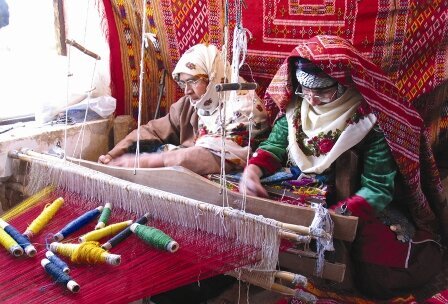Tehran – Zabin, located in Carat County in Korasan Razabi Province, is known as one of the hearts of Iran’s silk weaving. Registered as a national silk fabric city in 2023, Zabin boasts a rich history and a diverse culture.
In fact, the art of Zabin silk weave as a cultural heritage is a sign of the arts and creativity of the locals. It also shows the rich history and culture of the clans living in the area, Isna wrote.
Silk fabrics, dating back to the past few centuries, have transformed into a critical industry within years. As a source of income for households, silk weave art plays an important role in local culture and customs.
Handicraft experts said that due to the comfortable weather and geographical conditions, Zabin is the right place to breed silkworms and produce natural silk. “The industry was gradually considered to be one of the region’s economic and cultural pillars, and many households were involved in it.”
Marjan Khodsetan added that silk fabrics are considered the art and industry of Zabin and support local culture and identity.
Kalat City, and Zavin in particular, are home to a variety of ethnic groups, each known for their own customs and traditions. This ethnic and cultural diversity is one of the unique features of the region. Each ethnic group has its own special clothing and attire that is applied to local ceremonies and celebrations.
Local clothing is known as a tourist attraction in Carat, and says it will help showcase the area’s rich culture. A handicraft expert said:
She pointed out: This cultural diversity is reflected not only in languages and customs, but also in arts and crafts. Furthermore, silk weaving in zabin is known as a common cultural element among these ethnic groups and helps to strengthen the social and cultural connections between them.
Local clothing and tourist attractions
Noting that the local clothing in Carat is very noticeable, especially at special ceremonies such as weddings, “The clothing produced in this region is not only beautiful and unique, but also shows the cultural identity of each ethnic group. These clothing are made of natural fibers and have a diverse range of designs and colors.
She said Zavin’s local clothing has a unique design, and “these clothes use a variety of colours and traditional patterns, which attracts the attention of all viewers.”
Khodsetan says these clothes usually include long skirts, beautiful blouses, and even a variety of accessories that enhance beauty.
She continued that while most of the clothing produced in Zabin is used in the city, some manufacturers will update their products and take part in international exhibitions and offer them to the global market. The measure not only helps increase family income, but also helps to introduce Zabin’s culture and art to the world, she added.
Local clothing workshop
There are 300-350 local clothing workshops operated in Zabin. These workshops produce a variety of local and silk clothing, and their products are attracting attention for their beauty and high quality. Furthermore, the products in these workshops are like each have unique features and designs that reflect the art and taste of local artists.
She said that each Silk Weaving workshop in Zabin is usually run by a family, helping to maintain the family tradition and pass on skills to a new generation, and that “women play an important role in these workshops and are recognized as the leading artists and producers of Silk Weaving.”
She continued that local women produced silk fabrics decorated with beautiful designs and were applied in various rituals.
Khodsetan said the silk weaving industry will bring about a change in the way women and men work together to share cultural experiences.
Local and silk dress production is family-run, thus promoting social and cultural relations among family and community members.
Training and knowledge transfer
One of the challenges facing the silk weaving industry is transferring knowledge and skills to younger generations. Many elder women are familiar with this art, but young people are less interested in these fields. Therefore, holding training workshops and training courses for young people can help maintain and promote this ancient art.
Some local Dressweaver believes these workshops can inspire young people to learn these skills and transfer them to future generations.
Khodsetan noted that holding training courses involves mastering silk weaving skills, local dress design and accustomed to new production techniques.
She said she could expect the silk weaving in Zabin to be considered a more tourist attraction than before. It will help attract domestic and international tourists and create more employment opportunities for local people, she added.
KD

